FORD E SERIES 2008 4.G Owners Manual
Manufacturer: FORD, Model Year: 2008, Model line: E SERIES, Model: FORD E SERIES 2008 4.GPages: 280, PDF Size: 2.56 MB
Page 151 of 280
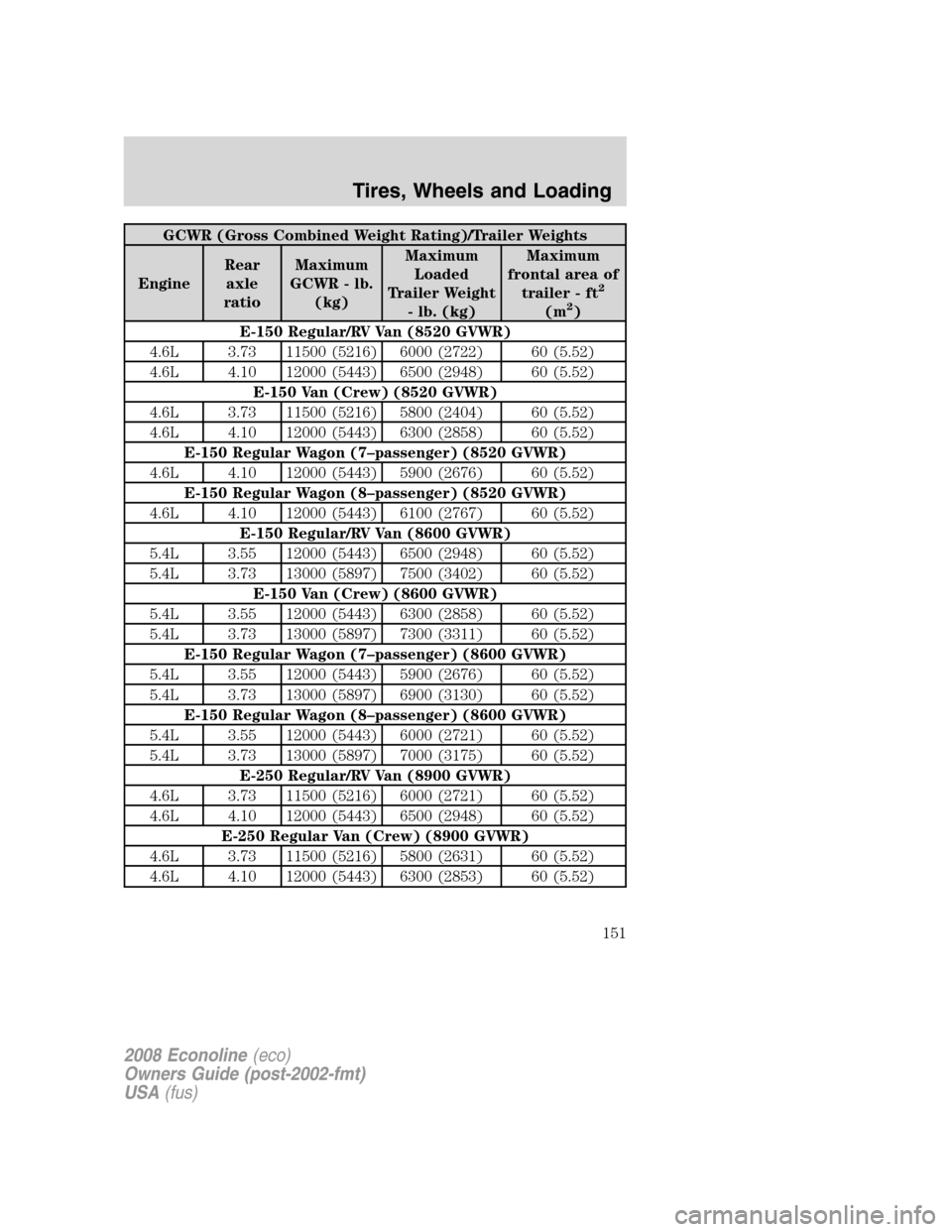
GCWR (Gross Combined Weight Rating)/Trailer Weights
EngineRear
axle
ratioMaximum
GCWR - lb.
(kg)Maximum
Loaded
Trailer Weight
- lb. (kg)Maximum
frontal area of
trailer - ft
2
(m2)
E-150 Regular/RV Van (8520 GVWR)
4.6L 3.73 11500 (5216) 6000 (2722) 60 (5.52)
4.6L 4.10 12000 (5443) 6500 (2948) 60 (5.52)
E-150 Van (Crew) (8520 GVWR)
4.6L 3.73 11500 (5216) 5800 (2404) 60 (5.52)
4.6L 4.10 12000 (5443) 6300 (2858) 60 (5.52)
E-150 Regular Wagon (7–passenger) (8520 GVWR)
4.6L 4.10 12000 (5443) 5900 (2676) 60 (5.52)
E-150 Regular Wagon (8–passenger) (8520 GVWR)
4.6L 4.10 12000 (5443) 6100 (2767) 60 (5.52)
E-150 Regular/RV Van (8600 GVWR)
5.4L 3.55 12000 (5443) 6500 (2948) 60 (5.52)
5.4L 3.73 13000 (5897) 7500 (3402) 60 (5.52)
E-150 Van (Crew) (8600 GVWR)
5.4L 3.55 12000 (5443) 6300 (2858) 60 (5.52)
5.4L 3.73 13000 (5897) 7300 (3311) 60 (5.52)
E-150 Regular Wagon (7–passenger) (8600 GVWR)
5.4L 3.55 12000 (5443) 5900 (2676) 60 (5.52)
5.4L 3.73 13000 (5897) 6900 (3130) 60 (5.52)
E-150 Regular Wagon (8–passenger) (8600 GVWR)
5.4L 3.55 12000 (5443) 6000 (2721) 60 (5.52)
5.4L 3.73 13000 (5897) 7000 (3175) 60 (5.52)
E-250 Regular/RV Van (8900 GVWR)
4.6L 3.73 11500 (5216) 6000 (2721) 60 (5.52)
4.6L 4.10 12000 (5443) 6500 (2948) 60 (5.52)
E-250 Regular Van (Crew) (8900 GVWR)
4.6L 3.73 11500 (5216) 5800 (2631) 60 (5.52)
4.6L 4.10 12000 (5443) 6300 (2853) 60 (5.52)
2008 Econoline(eco)
Owners Guide (post-2002-fmt)
USA(fus)
Tires, Wheels and Loading
151
Page 152 of 280
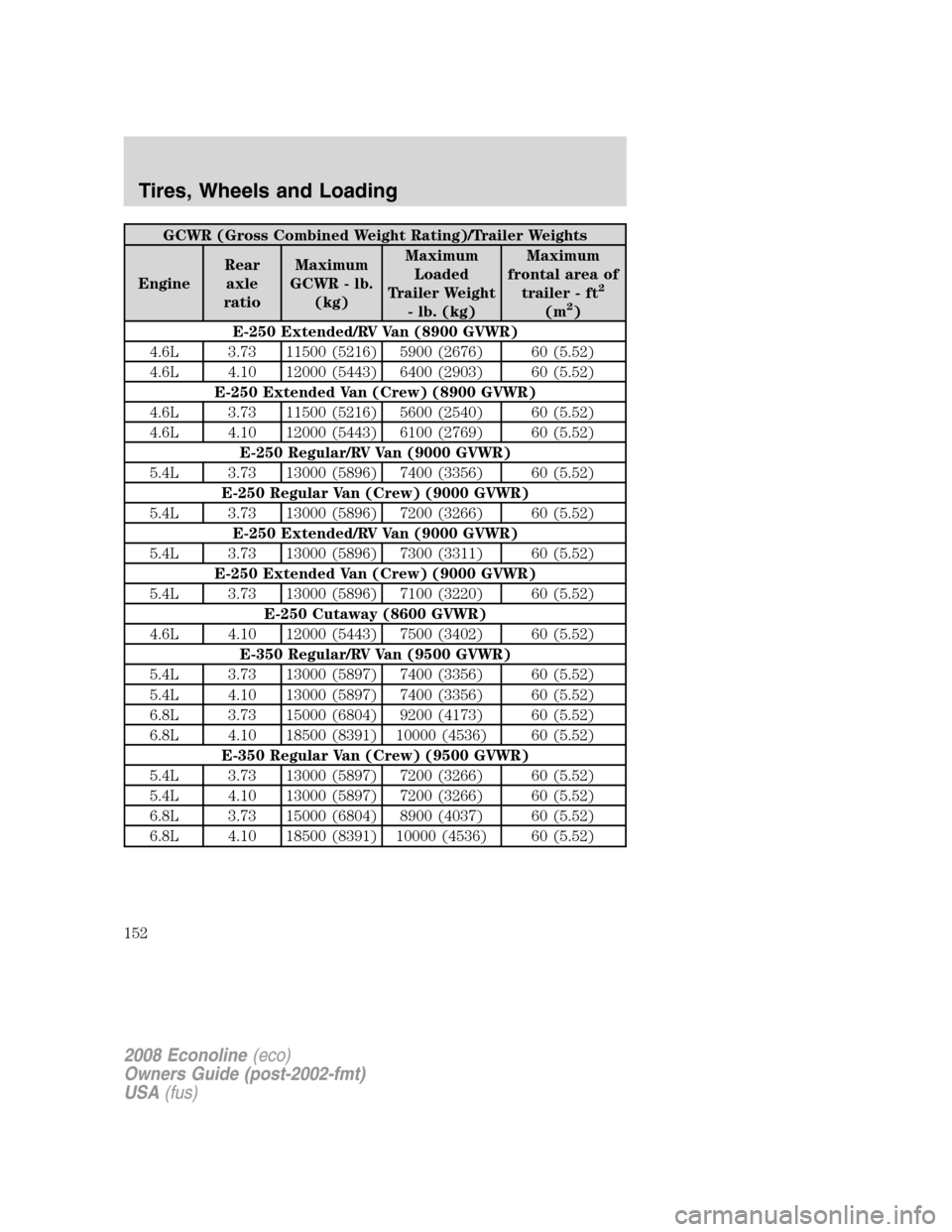
GCWR (Gross Combined Weight Rating)/Trailer Weights
EngineRear
axle
ratioMaximum
GCWR - lb.
(kg)Maximum
Loaded
Trailer Weight
- lb. (kg)Maximum
frontal area of
trailer - ft
2
(m2)
E-250 Extended/RV Van (8900 GVWR)
4.6L 3.73 11500 (5216) 5900 (2676) 60 (5.52)
4.6L 4.10 12000 (5443) 6400 (2903) 60 (5.52)
E-250 Extended Van (Crew) (8900 GVWR)
4.6L 3.73 11500 (5216) 5600 (2540) 60 (5.52)
4.6L 4.10 12000 (5443) 6100 (2769) 60 (5.52)
E-250 Regular/RV Van (9000 GVWR)
5.4L 3.73 13000 (5896) 7400 (3356) 60 (5.52)
E-250 Regular Van (Crew) (9000 GVWR)
5.4L 3.73 13000 (5896) 7200 (3266) 60 (5.52)
E-250 Extended/RV Van (9000 GVWR)
5.4L 3.73 13000 (5896) 7300 (3311) 60 (5.52)
E-250 Extended Van (Crew) (9000 GVWR)
5.4L 3.73 13000 (5896) 7100 (3220) 60 (5.52)
E-250 Cutaway (8600 GVWR)
4.6L 4.10 12000 (5443) 7500 (3402) 60 (5.52)
E-350 Regular/RV Van (9500 GVWR)
5.4L 3.73 13000 (5897) 7400 (3356) 60 (5.52)
5.4L 4.10 13000 (5897) 7400 (3356) 60 (5.52)
6.8L 3.73 15000 (6804) 9200 (4173) 60 (5.52)
6.8L 4.10 18500 (8391) 10000 (4536) 60 (5.52)
E-350 Regular Van (Crew) (9500 GVWR)
5.4L 3.73 13000 (5897) 7200 (3266) 60 (5.52)
5.4L 4.10 13000 (5897) 7200 (3266) 60 (5.52)
6.8L 3.73 15000 (6804) 8900 (4037) 60 (5.52)
6.8L 4.10 18500 (8391) 10000 (4536) 60 (5.52)
2008 Econoline(eco)
Owners Guide (post-2002-fmt)
USA(fus)
Tires, Wheels and Loading
152
Page 153 of 280
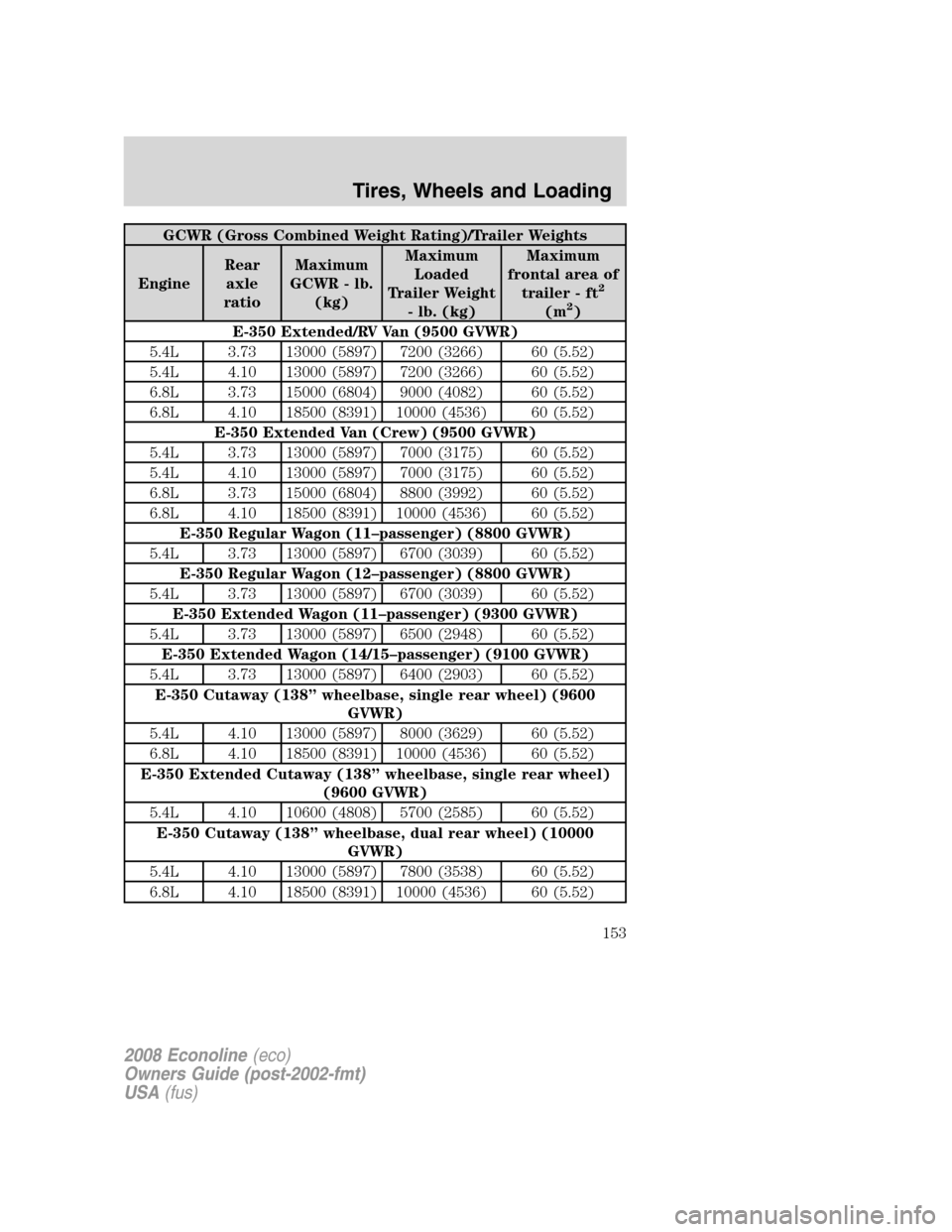
GCWR (Gross Combined Weight Rating)/Trailer Weights
EngineRear
axle
ratioMaximum
GCWR - lb.
(kg)Maximum
Loaded
Trailer Weight
- lb. (kg)Maximum
frontal area of
trailer - ft
2
(m2)
E-350 Extended/RV Van (9500 GVWR)
5.4L 3.73 13000 (5897) 7200 (3266) 60 (5.52)
5.4L 4.10 13000 (5897) 7200 (3266) 60 (5.52)
6.8L 3.73 15000 (6804) 9000 (4082) 60 (5.52)
6.8L 4.10 18500 (8391) 10000 (4536) 60 (5.52)
E-350 Extended Van (Crew) (9500 GVWR)
5.4L 3.73 13000 (5897) 7000 (3175) 60 (5.52)
5.4L 4.10 13000 (5897) 7000 (3175) 60 (5.52)
6.8L 3.73 15000 (6804) 8800 (3992) 60 (5.52)
6.8L 4.10 18500 (8391) 10000 (4536) 60 (5.52)
E-350 Regular Wagon (11–passenger) (8800 GVWR)
5.4L 3.73 13000 (5897) 6700 (3039) 60 (5.52)
E-350 Regular Wagon (12–passenger) (8800 GVWR)
5.4L 3.73 13000 (5897) 6700 (3039) 60 (5.52)
E-350 Extended Wagon (11–passenger) (9300 GVWR)
5.4L 3.73 13000 (5897) 6500 (2948) 60 (5.52)
E-350 Extended Wagon (14/15–passenger) (9100 GVWR)
5.4L 3.73 13000 (5897) 6400 (2903) 60 (5.52)
E-350 Cutaway (138” wheelbase, single rear wheel) (9600
GVWR)
5.4L 4.10 13000 (5897) 8000 (3629) 60 (5.52)
6.8L 4.10 18500 (8391) 10000 (4536) 60 (5.52)
E-350 Extended Cutaway (138” wheelbase, single rear wheel)
(9600 GVWR)
5.4L 4.10 10600 (4808) 5700 (2585) 60 (5.52)
E-350 Cutaway (138” wheelbase, dual rear wheel) (10000
GVWR)
5.4L 4.10 13000 (5897) 7800 (3538) 60 (5.52)
6.8L 4.10 18500 (8391) 10000 (4536) 60 (5.52)
2008 Econoline(eco)
Owners Guide (post-2002-fmt)
USA(fus)
Tires, Wheels and Loading
153
Page 154 of 280
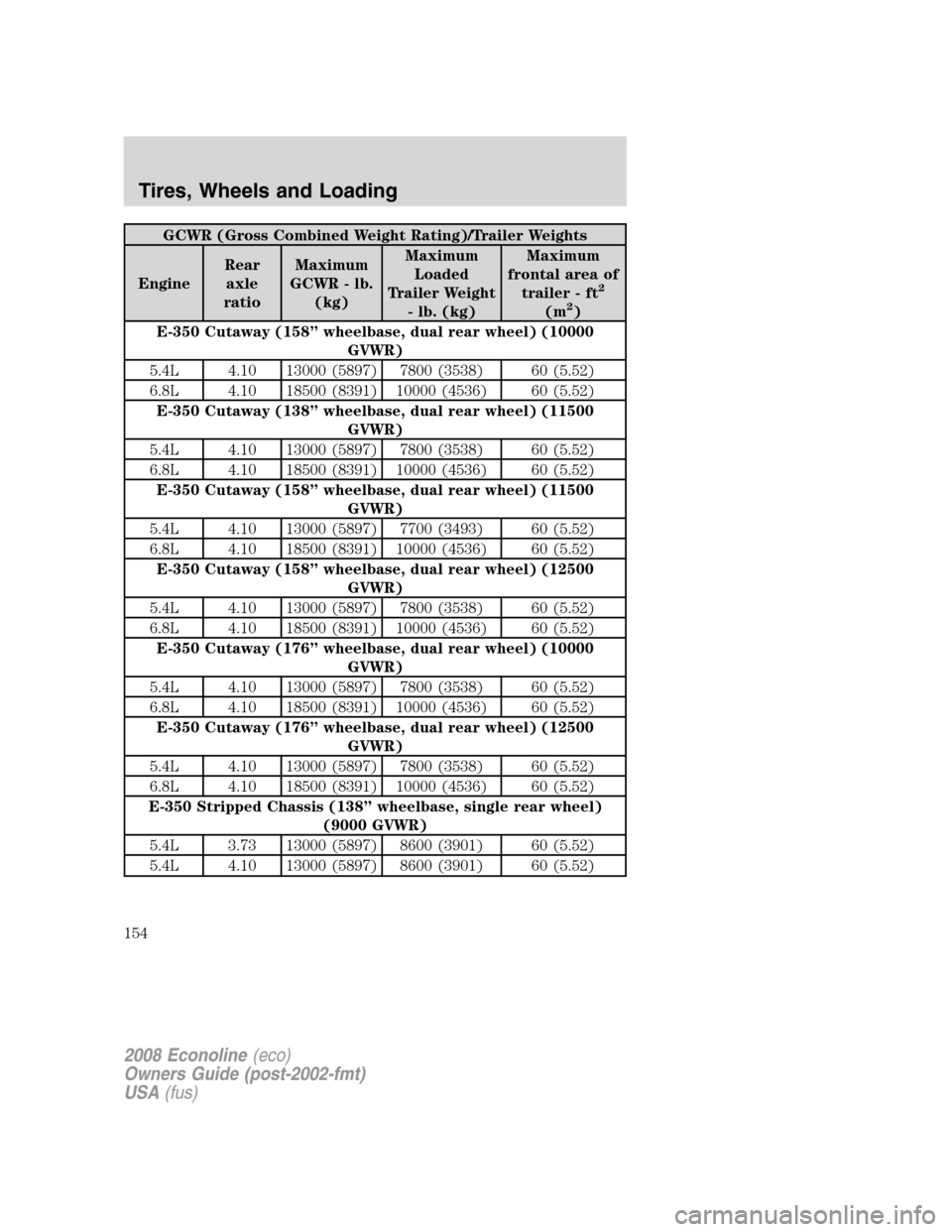
GCWR (Gross Combined Weight Rating)/Trailer Weights
EngineRear
axle
ratioMaximum
GCWR - lb.
(kg)Maximum
Loaded
Trailer Weight
- lb. (kg)Maximum
frontal area of
trailer - ft
2
(m2)
E-350 Cutaway (158” wheelbase, dual rear wheel) (10000
GVWR)
5.4L 4.10 13000 (5897) 7800 (3538) 60 (5.52)
6.8L 4.10 18500 (8391) 10000 (4536) 60 (5.52)
E-350 Cutaway (138” wheelbase, dual rear wheel) (11500
GVWR)
5.4L 4.10 13000 (5897) 7800 (3538) 60 (5.52)
6.8L 4.10 18500 (8391) 10000 (4536) 60 (5.52)
E-350 Cutaway (158” wheelbase, dual rear wheel) (11500
GVWR)
5.4L 4.10 13000 (5897) 7700 (3493) 60 (5.52)
6.8L 4.10 18500 (8391) 10000 (4536) 60 (5.52)
E-350 Cutaway (158” wheelbase, dual rear wheel) (12500
GVWR)
5.4L 4.10 13000 (5897) 7800 (3538) 60 (5.52)
6.8L 4.10 18500 (8391) 10000 (4536) 60 (5.52)
E-350 Cutaway (176” wheelbase, dual rear wheel) (10000
GVWR)
5.4L 4.10 13000 (5897) 7800 (3538) 60 (5.52)
6.8L 4.10 18500 (8391) 10000 (4536) 60 (5.52)
E-350 Cutaway (176” wheelbase, dual rear wheel) (12500
GVWR)
5.4L 4.10 13000 (5897) 7800 (3538) 60 (5.52)
6.8L 4.10 18500 (8391) 10000 (4536) 60 (5.52)
E-350 Stripped Chassis (138” wheelbase, single rear wheel)
(9000 GVWR)
5.4L 3.73 13000 (5897) 8600 (3901) 60 (5.52)
5.4L 4.10 13000 (5897) 8600 (3901) 60 (5.52)
2008 Econoline(eco)
Owners Guide (post-2002-fmt)
USA(fus)
Tires, Wheels and Loading
154
Page 155 of 280
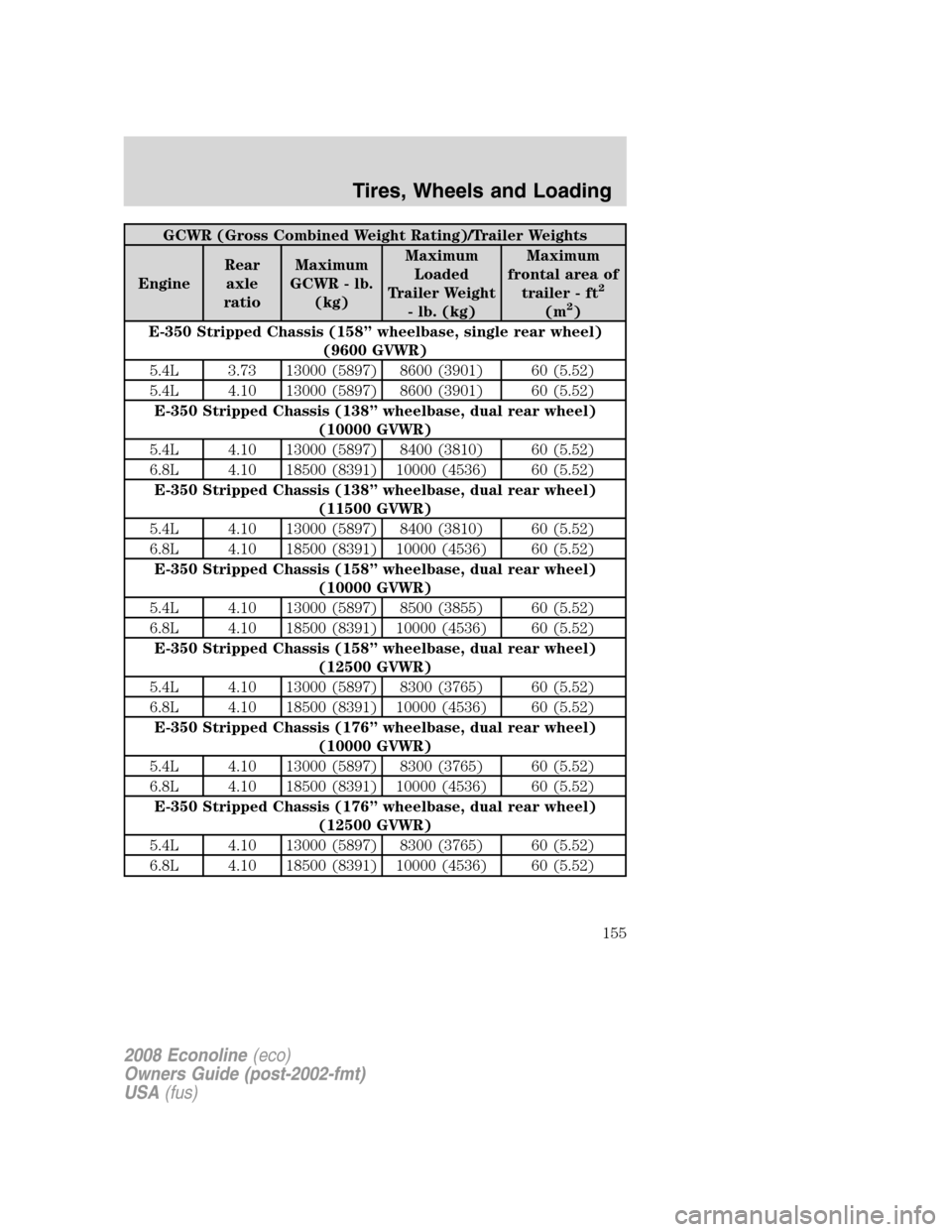
GCWR (Gross Combined Weight Rating)/Trailer Weights
EngineRear
axle
ratioMaximum
GCWR - lb.
(kg)Maximum
Loaded
Trailer Weight
- lb. (kg)Maximum
frontal area of
trailer - ft
2
(m2)
E-350 Stripped Chassis (158” wheelbase, single rear wheel)
(9600 GVWR)
5.4L 3.73 13000 (5897) 8600 (3901) 60 (5.52)
5.4L 4.10 13000 (5897) 8600 (3901) 60 (5.52)
E-350 Stripped Chassis (138” wheelbase, dual rear wheel)
(10000 GVWR)
5.4L 4.10 13000 (5897) 8400 (3810) 60 (5.52)
6.8L 4.10 18500 (8391) 10000 (4536) 60 (5.52)
E-350 Stripped Chassis (138” wheelbase, dual rear wheel)
(11500 GVWR)
5.4L 4.10 13000 (5897) 8400 (3810) 60 (5.52)
6.8L 4.10 18500 (8391) 10000 (4536) 60 (5.52)
E-350 Stripped Chassis (158” wheelbase, dual rear wheel)
(10000 GVWR)
5.4L 4.10 13000 (5897) 8500 (3855) 60 (5.52)
6.8L 4.10 18500 (8391) 10000 (4536) 60 (5.52)
E-350 Stripped Chassis (158” wheelbase, dual rear wheel)
(12500 GVWR)
5.4L 4.10 13000 (5897) 8300 (3765) 60 (5.52)
6.8L 4.10 18500 (8391) 10000 (4536) 60 (5.52)
E-350 Stripped Chassis (176” wheelbase, dual rear wheel)
(10000 GVWR)
5.4L 4.10 13000 (5897) 8300 (3765) 60 (5.52)
6.8L 4.10 18500 (8391) 10000 (4536) 60 (5.52)
E-350 Stripped Chassis (176” wheelbase, dual rear wheel)
(12500 GVWR)
5.4L 4.10 13000 (5897) 8300 (3765) 60 (5.52)
6.8L 4.10 18500 (8391) 10000 (4536) 60 (5.52)
2008 Econoline(eco)
Owners Guide (post-2002-fmt)
USA(fus)
Tires, Wheels and Loading
155
Page 156 of 280
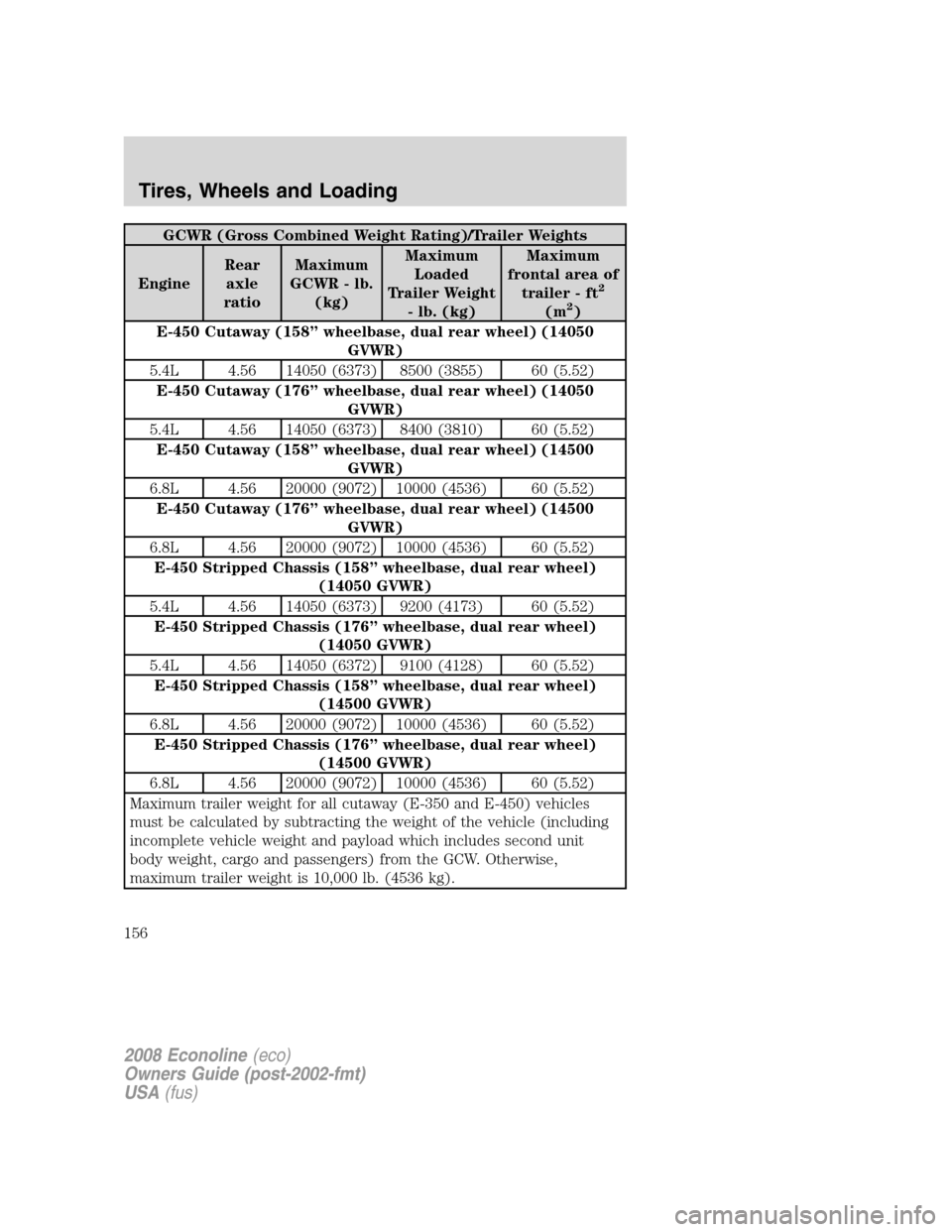
GCWR (Gross Combined Weight Rating)/Trailer Weights
EngineRear
axle
ratioMaximum
GCWR - lb.
(kg)Maximum
Loaded
Trailer Weight
- lb. (kg)Maximum
frontal area of
trailer - ft
2
(m2)
E-450 Cutaway (158” wheelbase, dual rear wheel) (14050
GVWR)
5.4L 4.56 14050 (6373) 8500 (3855) 60 (5.52)
E-450 Cutaway (176” wheelbase, dual rear wheel) (14050
GVWR)
5.4L 4.56 14050 (6373) 8400 (3810) 60 (5.52)
E-450 Cutaway (158” wheelbase, dual rear wheel) (14500
GVWR)
6.8L 4.56 20000 (9072) 10000 (4536) 60 (5.52)
E-450 Cutaway (176” wheelbase, dual rear wheel) (14500
GVWR)
6.8L 4.56 20000 (9072) 10000 (4536) 60 (5.52)
E-450 Stripped Chassis (158” wheelbase, dual rear wheel)
(14050 GVWR)
5.4L 4.56 14050 (6373) 9200 (4173) 60 (5.52)
E-450 Stripped Chassis (176” wheelbase, dual rear wheel)
(14050 GVWR)
5.4L 4.56 14050 (6372) 9100 (4128) 60 (5.52)
E-450 Stripped Chassis (158” wheelbase, dual rear wheel)
(14500 GVWR)
6.8L 4.56 20000 (9072) 10000 (4536) 60 (5.52)
E-450 Stripped Chassis (176” wheelbase, dual rear wheel)
(14500 GVWR)
6.8L 4.56 20000 (9072) 10000 (4536) 60 (5.52)
Maximum trailer weight for all cutaway (E-350 and E-450) vehicles
must be calculated by subtracting the weight of the vehicle (including
incomplete vehicle weight and payload which includes second unit
body weight, cargo and passengers) from the GCW. Otherwise,
maximum trailer weight is 10,000 lb. (4536 kg).
2008 Econoline(eco)
Owners Guide (post-2002-fmt)
USA(fus)
Tires, Wheels and Loading
156
Page 157 of 280
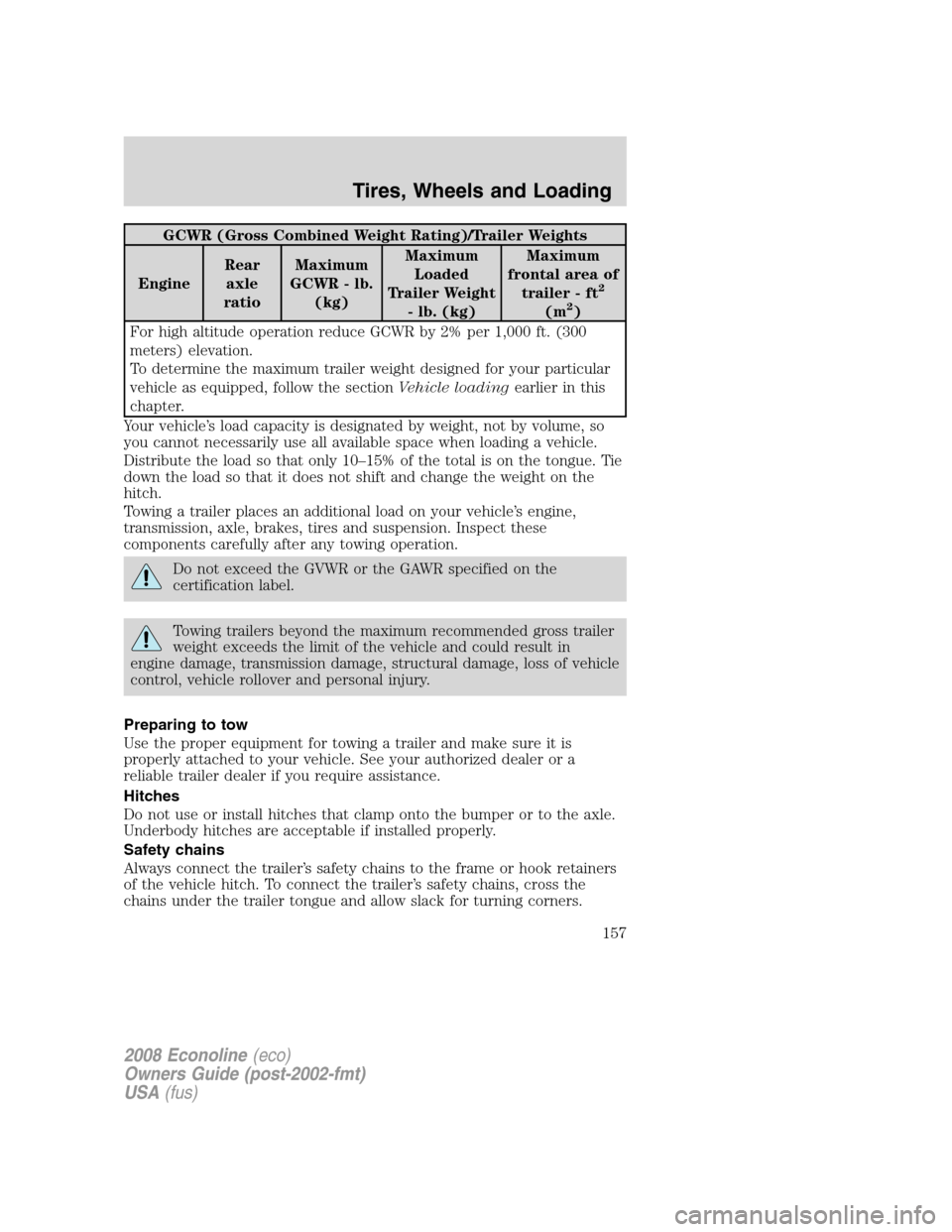
GCWR (Gross Combined Weight Rating)/Trailer Weights
EngineRear
axle
ratioMaximum
GCWR - lb.
(kg)Maximum
Loaded
Trailer Weight
- lb. (kg)Maximum
frontal area of
trailer - ft
2
(m2)
For high altitude operation reduce GCWR by 2% per 1,000 ft. (300
meters) elevation.
To determine the maximum trailer weight designed for your particular
vehicle as equipped, follow the sectionVehicle loadingearlier in this
chapter.
Your vehicle’s load capacity is designated by weight, not by volume, so
you cannot necessarily use all available space when loading a vehicle.
Distribute the load so that only 10–15% of the total is on the tongue. Tie
down the load so that it does not shift and change the weight on the
hitch.
Towing a trailer places an additional load on your vehicle’s engine,
transmission, axle, brakes, tires and suspension. Inspect these
components carefully after any towing operation.
Do not exceed the GVWR or the GAWR specified on the
certification label.
Towing trailers beyond the maximum recommended gross trailer
weight exceeds the limit of the vehicle and could result in
engine damage, transmission damage, structural damage, loss of vehicle
control, vehicle rollover and personal injury.
Preparing to tow
Use the proper equipment for towing a trailer and make sure it is
properly attached to your vehicle. See your authorized dealer or a
reliable trailer dealer if you require assistance.
Hitches
Do not use or install hitches that clamp onto the bumper or to the axle.
Underbody hitches are acceptable if installed properly.
Safety chains
Always connect the trailer’s safety chains to the frame or hook retainers
of the vehicle hitch. To connect the trailer’s safety chains, cross the
chains under the trailer tongue and allow slack for turning corners.
2008 Econoline(eco)
Owners Guide (post-2002-fmt)
USA(fus)
Tires, Wheels and Loading
157
Page 158 of 280
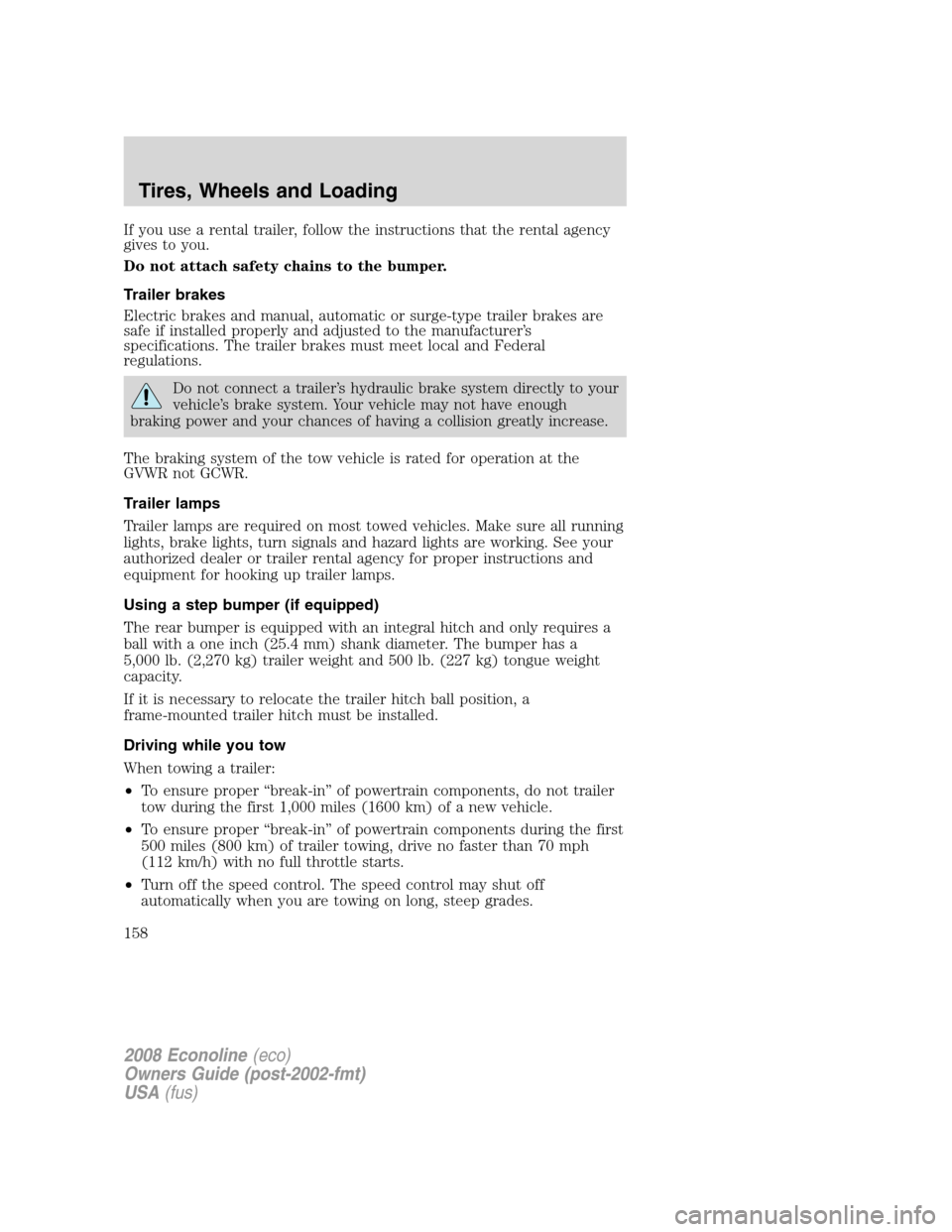
If you use a rental trailer, follow the instructions that the rental agency
gives to you.
Do not attach safety chains to the bumper.
Trailer brakes
Electric brakes and manual, automatic or surge-type trailer brakes are
safe if installed properly and adjusted to the manufacturer’s
specifications. The trailer brakes must meet local and Federal
regulations.
Do not connect a trailer’s hydraulic brake system directly to your
vehicle’s brake system. Your vehicle may not have enough
braking power and your chances of having a collision greatly increase.
The braking system of the tow vehicle is rated for operation at the
GVWR not GCWR.
Trailer lamps
Trailer lamps are required on most towed vehicles. Make sure all running
lights, brake lights, turn signals and hazard lights are working. See your
authorized dealer or trailer rental agency for proper instructions and
equipment for hooking up trailer lamps.
Using a step bumper (if equipped)
The rear bumper is equipped with an integral hitch and only requires a
ball with a one inch (25.4 mm) shank diameter. The bumper has a
5,000 lb. (2,270 kg) trailer weight and 500 lb. (227 kg) tongue weight
capacity.
If it is necessary to relocate the trailer hitch ball position, a
frame-mounted trailer hitch must be installed.
Driving while you tow
When towing a trailer:
•To ensure proper “break-in” of powertrain components, do not trailer
tow during the first 1,000 miles (1600 km) of a new vehicle.
•To ensure proper “break-in” of powertrain components during the first
500 miles (800 km) of trailer towing, drive no faster than 70 mph
(112 km/h) with no full throttle starts.
•Turn off the speed control. The speed control may shut off
automatically when you are towing on long, steep grades.
2008 Econoline(eco)
Owners Guide (post-2002-fmt)
USA(fus)
Tires, Wheels and Loading
158
Page 159 of 280
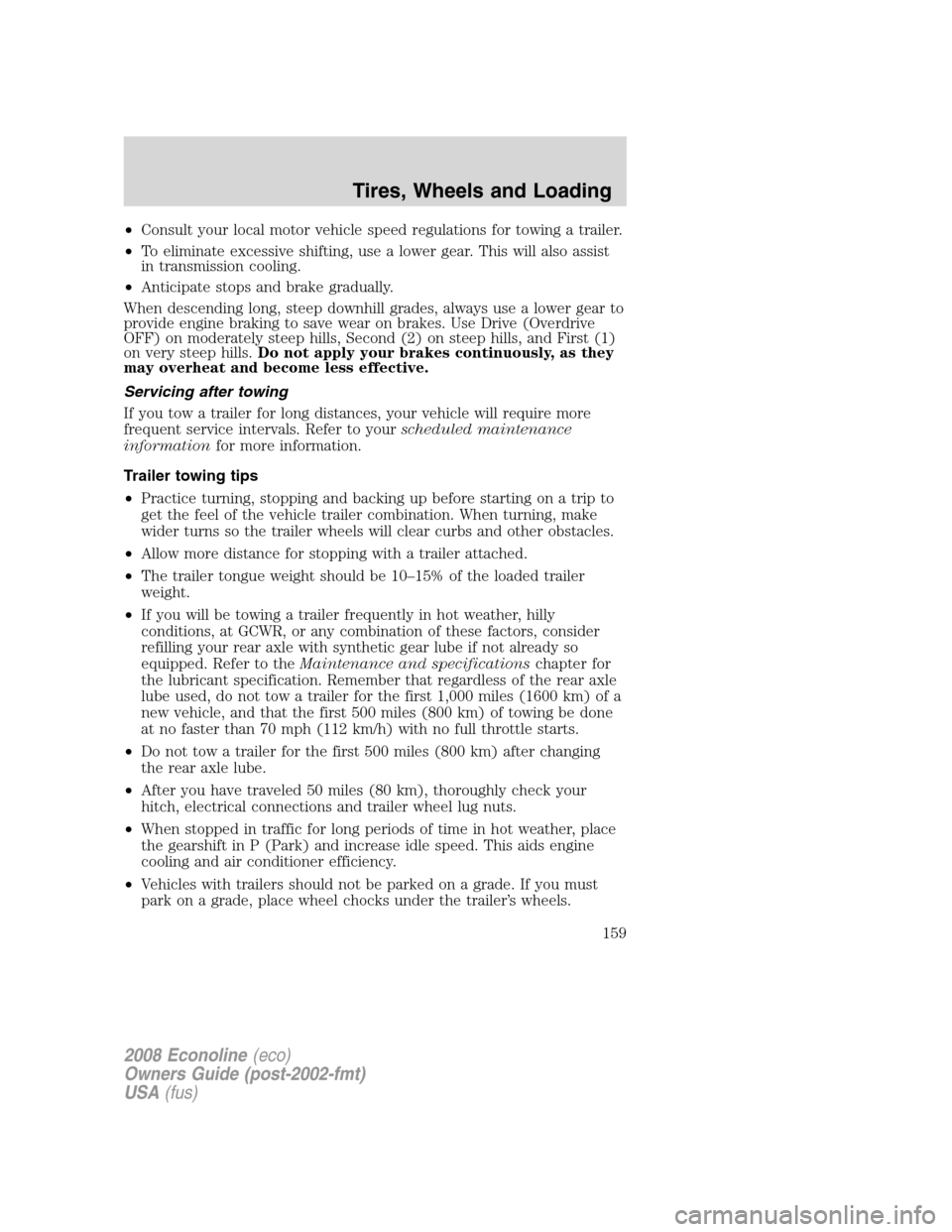
•Consult your local motor vehicle speed regulations for towing a trailer.
•To eliminate excessive shifting, use a lower gear. This will also assist
in transmission cooling.
•Anticipate stops and brake gradually.
When descending long, steep downhill grades, always use a lower gear to
provide engine braking to save wear on brakes. Use Drive (Overdrive
OFF) on moderately steep hills, Second (2) on steep hills, and First (1)
on very steep hills.Do not apply your brakes continuously, as they
may overheat and become less effective.
Servicing after towing
If you tow a trailer for long distances, your vehicle will require more
frequent service intervals. Refer to yourscheduled maintenance
informationfor more information.
Trailer towing tips
•Practice turning, stopping and backing up before starting on a trip to
get the feel of the vehicle trailer combination. When turning, make
wider turns so the trailer wheels will clear curbs and other obstacles.
•Allow more distance for stopping with a trailer attached.
•The trailer tongue weight should be 10–15% of the loaded trailer
weight.
•If you will be towing a trailer frequently in hot weather, hilly
conditions, at GCWR, or any combination of these factors, consider
refilling your rear axle with synthetic gear lube if not already so
equipped. Refer to theMaintenance and specificationschapter for
the lubricant specification. Remember that regardless of the rear axle
lube used, do not tow a trailer for the first 1,000 miles (1600 km) of a
new vehicle, and that the first 500 miles (800 km) of towing be done
at no faster than 70 mph (112 km/h) with no full throttle starts.
•Do not tow a trailer for the first 500 miles (800 km) after changing
the rear axle lube.
•After you have traveled 50 miles (80 km), thoroughly check your
hitch, electrical connections and trailer wheel lug nuts.
•When stopped in traffic for long periods of time in hot weather, place
the gearshift in P (Park) and increase idle speed. This aids engine
cooling and air conditioner efficiency.
•Vehicles with trailers should not be parked on a grade. If you must
park on a grade, place wheel chocks under the trailer’s wheels.
2008 Econoline(eco)
Owners Guide (post-2002-fmt)
USA(fus)
Tires, Wheels and Loading
159
Page 160 of 280
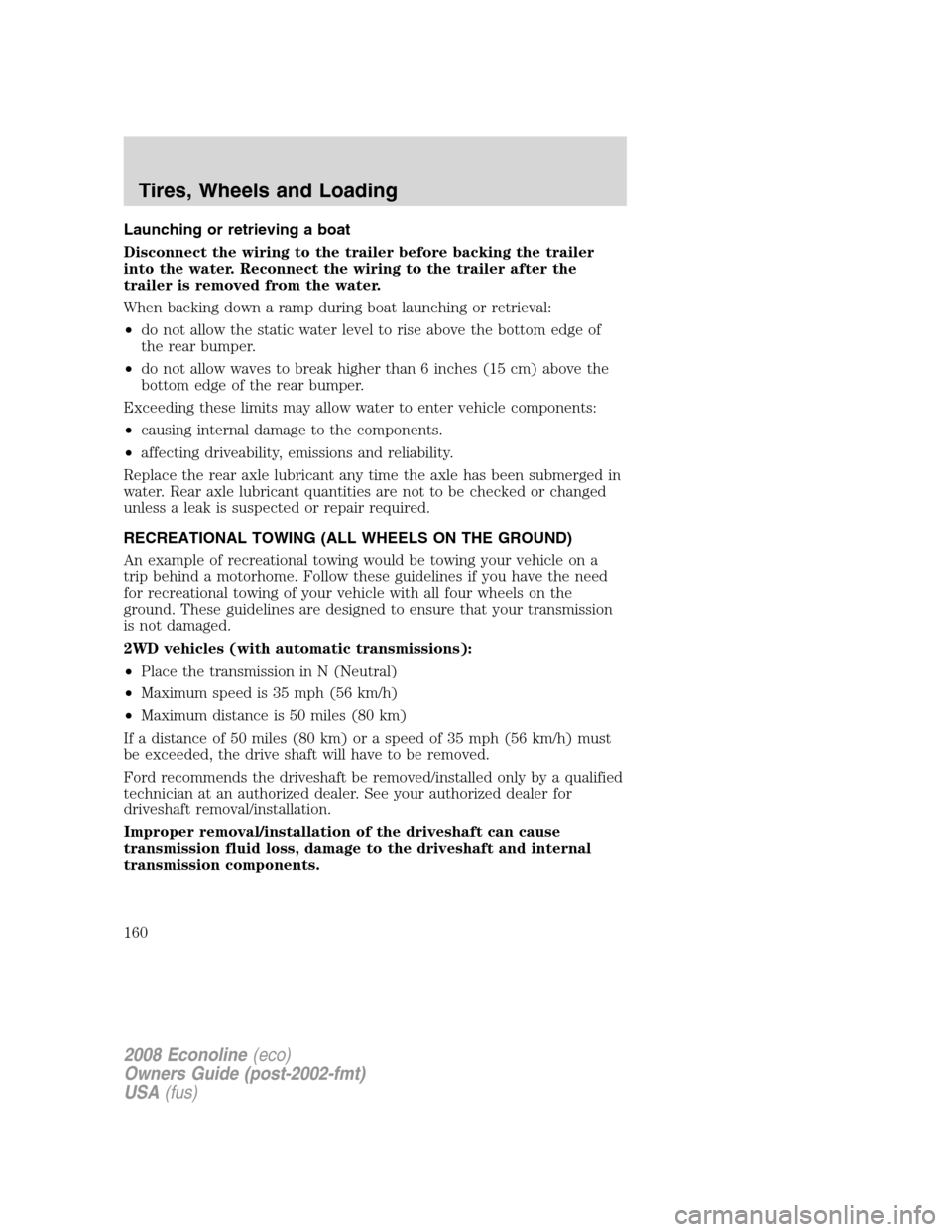
Launching or retrieving a boat
Disconnect the wiring to the trailer before backing the trailer
into the water. Reconnect the wiring to the trailer after the
trailer is removed from the water.
When backing down a ramp during boat launching or retrieval:
•do not allow the static water level to rise above the bottom edge of
the rear bumper.
•do not allow waves to break higher than 6 inches (15 cm) above the
bottom edge of the rear bumper.
Exceeding these limits may allow water to enter vehicle components:
•causing internal damage to the components.
•affecting driveability, emissions and reliability.
Replace the rear axle lubricant any time the axle has been submerged in
water. Rear axle lubricant quantities are not to be checked or changed
unless a leak is suspected or repair required.
RECREATIONAL TOWING (ALL WHEELS ON THE GROUND)
An example of recreational towing would be towing your vehicle on a
trip behind a motorhome. Follow these guidelines if you have the need
for recreational towing of your vehicle with all four wheels on the
ground. These guidelines are designed to ensure that your transmission
is not damaged.
2WD vehicles (with automatic transmissions):
•Place the transmission in N (Neutral)
•Maximum speed is 35 mph (56 km/h)
•Maximum distance is 50 miles (80 km)
If a distance of 50 miles (80 km) or a speed of 35 mph (56 km/h) must
be exceeded, the drive shaft will have to be removed.
Ford recommends the driveshaft be removed/installed only by a qualified
technician at an authorized dealer. See your authorized dealer for
driveshaft removal/installation.
Improper removal/installation of the driveshaft can cause
transmission fluid loss, damage to the driveshaft and internal
transmission components.
2008 Econoline(eco)
Owners Guide (post-2002-fmt)
USA(fus)
Tires, Wheels and Loading
160